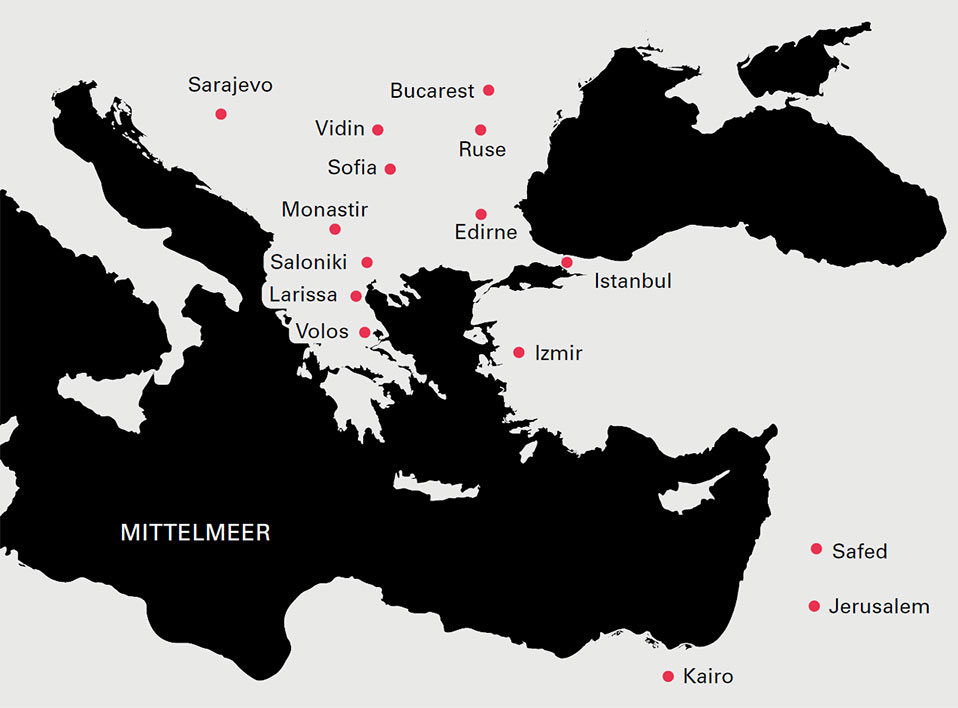Judeo-Spanish: An almost forgotten language
Text: Olivia Poisson
In the late Middle Ages, many Jews who had been exiled from Spain or Portugal migrated to the Ottoman Empire. Their language, Judeo- Spanish, survives in a few pockets. Research on it is shedding a light on how languages in general develop.
If you try to read an Old English text from the 9th century, chances are that you will find it well-nigh impenetrable – not only because its content will seem foreign, but also because English grammar and spelling have changed dramatically over the centuries. All languages evolve and change continuously. In some cases, a language variety will split off from its parent language by developing divergently over time, and it is not uncommon for a language to simply become extinct. Why this is the case and how exactly the process works are some of the major questions in linguistics.
Language birth and death
At the University of Basel, Beatrice Schmid, Professor of Iberian Romance Languages, has been researching language history and language contact since 1999. Much of her work is concerned with investigating and documenting modern written Judeo-Spanish (judeoespañol) or Ladino, the traditional language of Sephardi Jews in the former Ottoman Empire. Sephardi Jews are descendants of Jews who lived in Spain and Portugal until they were forced to flee in the late 15th century. Up until the early 20th century, Judeo-Spanish was the main language of Jewish communities in the Ottoman Empire and was widely written as well as spoken. Following the demise of the empire and the formation of individual nation states such as Greece, Bulgaria, and Turkey, it was gradually supplanted by the respective nations’ languages.
Today, Judeo-Spanish is on the verge of extinction, but its history provides linguists with direct insight into how languages develop. “As a researcher trying to understand the evolution of languages, you’re forever wondering why a particular language developed in the way it did when it might well have developed differently. Judeo-Spanish is a fascinating, living example of an alternative path that Spanish could have taken, given different circumstances,” is how Schmid explains her fascination with the language.
Pioneering work
When she first offered courses on Judeo-Spanish, the subject area was receiving hardly any academic attention, and it remains a niche interest to this day. So how did she become interested in the first place? As is so often the case, coincidence played a large part: “I happened to be at a conference where two experts on Judeo-Spanish, who had a reputation for their heated debates, were scheduled to give a talk. I listened to it out of sheer curiosity and immediately became hooked,” she recalls.
“At Basel, I was originally going to offer a single series of lectures, along with a seminar, but my students practically forced me to carry on.” That was 16 years ago. Spurred on by her students’ enthusiastic participation, Schmid continues to offer courses on Judeo-Spanish every other semester.
Over the subsequent years, she established a research focus on Judeo-Spanish, which the University of Basel is still unique in Europe in offering. From 2002, Schmid and her students carried out trailblazing work, compiling the world’s first large-scale corpus of written Judeo-Spanish.
A corpus, a collection of texts in a particular language, is a prerequisite for linguistic research. Once the corpus had been assembled, the time-consuming task of transcribing the texts was undertaken. “From 2002 through 2006, we were busy making the corpus accessible. It was only afterwards that we began to reap the rewards of our work,” says Schmid. Specifically, this means that the sources have been used since then to study the peculiarities of written Judeo-Spanish from the latter half of the 19th century onward. This work has led to four doctoral theses and one postdoctoral Habilitation thesis. Prior to the efforts of Professor Schmid and her group of students, virtually no linguistic research had been conducted in this area. Only over the past ten years has the subject area gained a foothold in Israel and in the USA.
Influence of various cultures
In terms of its significance, Judeo-Spanish is to Sephardi Jews what Yiddish is to Ashkenazi Jews. It is a language that evolved over time under the influence of neighboring languages. Its origin lies in the expulsion of Jews from Spain and Portugal in 1492 and 1497, respectively. Before this turning point, Jews spoke Spanish no differently from the rest of the population. Hebrew was seldom used outside religious contexts, much like Latin among Catholics.
After their expulsion, many Spanish Jews migrated to the Ottoman Empire, taking their language with them. Sephardi communities were isolated enclaves within the multinational Ottoman state, which meant that Spanish remained their main language over the generations. Over the course of the centuries, under the influence of several surrounding languages, a distinct variety of Spanish came into existence. While the most obvious distinguishing characteristic of Judeo-Spanish is the fact that it is written in Hebrew script, it also shows many signs of influence from Turkish and Balkan languages.
No future for Judeo-Spanish Studies?
Schmid estimates that fewer than 50 linguists worldwide are currently working on Judeo-Spanish. With that in mind, what does she think the future holds for the field? “Judeo-Spanish will always sit on the periphery of linguistics. In spite of or even perhaps for this very reason, it does have a future as an academic subject area. Having said that, that future will, without a doubt, be in the USA, where many descendants of Sephardi Jews live, and in Israel, where most universities now offer Judeo-Spanish Studies as a focal area,” she explains.
The University of Basel has been helping to ensure a future for this area of research by producing a number of experts. For instance, the first doctoral student Schmid supervised is now a professor at the University of Bern, where she contributes to the teaching and research on this unique language.
Beatrice Schmid has taught and researched at the University of Basel since 1999 as professor of Ibero-Romance Linguistics where she heads the Judeo-Spanish research group. In recognition of her research on the Sephardic variety of the Spanish language, she was appointed corresponding member of the Royal Spanish Academy (Real Academia Española) in 2015.



